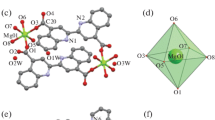Abstract
It has been established by single-crystal X-ray diffraction (XRD), differential scanning calorimetry, and luminescence spectroscopy that the color differences in the fluorescence of a 2-((2-(benzo[d]thiazol-2-yl)phenyl)carbamoyl)benzoic acid (I) luminophore is caused by the existence of its three structural forms, two of which are different crystalline modifications and one is amorphous. Under the UV irradiation, green, yellow, and orange glow of the compound is observed. The transition from the form with green glow to the form with yellow glow, as well as from the form with yellow glow to the form with orange glow, is a melt–crystal2 type phase transition rather than a crystal–crystal phase transition. In crystal structures, the intramolecular hydrogen bond weakens under the action of the intermolecular hydrogen bond. The stronger the newly formed bond, the weaker the intramolecular hydrogen bond is. The weakening of the intramolecular hydrogen bond is consistent with the red shift of the luminophore emission band.









Similar content being viewed by others
REFERENCES
L. G. Kuz’mina, S. Yu. Salykin, S. V. Kulagin, et al., Crystallogr. Rep. 3 (3), 413 (2021).
B. M. Krasovitskii and B. M. Bolotin, Organic Luminescent Materials (VCH Publishers, Weinheim, 1989).
Bruker, APEX2, SADABS, and SAINT (Bruker AXS Inc. Madison, Wiskonsi, USA, 2008).
O. V. Dolomanov, L. J. Bourhis, R. J. Gildea, et al., J. Appl. Crystallogr. 42, 339 (2009).
L. J. Bourhis, O. V. Dolomanov, R. J. Gildea, et al., Acta Crystallogr. A 71, 59 (2015). https://doi.org/10.1107/S2053273314027685
C. R. Groon and F. H. Allen, Angew. Chem. 53, 662 (2014).
D. Gobel, P. Rusch, D. Duvinage, et al., Chem. Commun. 56, 15430 (2020). https://doi.org/10.1039/DOCC05780K.57
M. Bakthadoss and R. Selvakumar, J. Org. Chem. 81, 3391 (2016).
D. Lakshmanan, R. M. Raj, R. Selvakumar, et al., Acta Crystallogr. E 67, o2259 (2011). https://doi.org/10.1107/S160053681103114X
H. Kargar, R. Kia, Z. Sharafi, et al., Acta Crystallogr. E 68, o2628 (2012). https://doi.org/10.1107/S1600536812033879
M. Tanimura, N. Watanabe, H. K. Ijuin, and M. Matsumoto, J. Org. Chem. 77, 4725 (2012). https://doi.org/10.1021/jo300417e
N. P. Thekkeppat, M. Lakshmipathi, A. S. Jalilov, et al., Cryst. Growth Des. 20 (6), 3937 (2020).
R. Wang, J. Ding, and Y. Zhang, New J. Chem. 43, 9152 (2019). https://doi.org/10.1039/c9nj01685f
T. K. Venkatachalam, G. K. Pierens, P. V. Bernhardt, and D. C. Reutens, Magn. Reson. Chem. 53, 448 (2015). https://doi.org/10.1002/mrc.4228
Y. Chen, Y. Fang, H. Gu, et al., ACS Appl. Mater. Interfaces 12, 55094 (2020). https://doi.org/10.2147/NDT.S308360
M. Singh, Vaishali, A. K. Paul, and V. Singh, Org. Biomol. Chem. 18, 4459 (2020).
D. Liu, Q. Ding, Y, Zh, and Y, Org Lett. 21 (8), 2523 (2019). https://doi.org/10.1021/acs.orglett.9b00115
A. A. Al-Amiery, A. A. Al-Temimi, A. A. H. Kadhum, et al., Zh. Strukt Khim. (Russ). 54, 593 (2013).
M. Tanimura, N. Watanabe, H. K. Ijuin, and M. Matsumoto, J. Org. Chem. 77, 4725 (2012). https://doi.org/10.1021/jo300417e
S. Goswami, A. K. Das, A. Manna, et al., Tetrahedron Lett. 55, 2633 (2014).
Author information
Authors and Affiliations
Corresponding authors
Ethics declarations
The authors declare that they have no conflicts of interest.
Additional information
Translated by E. Bondareva
Rights and permissions
About this article
Cite this article
Kuz’mina, L.G., Bezzubov, S.I., Kulagin, S.V. et al. Structure and Physicochemical Properties of Three Structural Forms of Organic Luminophore 2-((2-Benzo[d]thiazol-2-yl)phenyl)carbamoyl)benzoic Acid. Crystallogr. Rep. 67, 566–574 (2022). https://doi.org/10.1134/S1063774522030130
Received:
Revised:
Accepted:
Published:
Issue Date:
DOI: https://doi.org/10.1134/S1063774522030130




